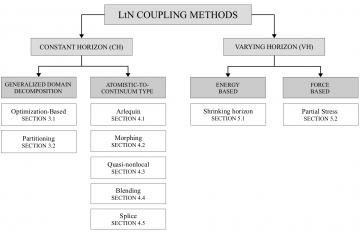
Achievement
This paper presents a review of the state-of-the-art of Local-to-Nonlocal (LtN) coupling for nonlocal diffusion and nonlocal mechanics, specifically peridynamics, and provides a classification of different LtN coupling approaches.
Significance and Impact
This review gives practitioners of LtN coupling a broad perspective on the diversity of LtN coupling techniques and the variety of ways to approach LtN coupling problems, both in terms of mathematical formulation and practical implementation.
Research Details
Following a description of various coupling configurations and a highlight of desired properties of a general LtN coupling strategy, we report different LtN coupling methods from the literature. For each method, we briefly present its mathematical formulation and properties, and we discuss relevant applications and numerical results.
Overview
Local-to-Nonlocal (LtN) coupling refers to a class of methods aimed at combining nonlocal and local modeling descriptions of a given system into a unified coupled representation. This allows to consolidate the accuracy of nonlocal models with the computational expediency of their local counterparts, while often simultaneously removing additional nonlocal modeling issues such as surface effects. The number and variety of proposed LtN coupling approaches have significantly grown in recent year, yet the field of LtN coupling continues to grow and still has open challenges. This review provides an overview of the state-of-the-art of LtN coupling in the context of nonlocal diffusion and nonlocal mechanics, specifically peridynamics. We present a classification of LtN coupling methods and discuss common features and challenges. The goal of this review is not to provide a preferred way to address LtN coupling but to present a broad perspective of the field, which would serve as guidance for practitioners in the selection of appropriate LtN coupling methods based on the characteristics and needs of the problem under consideration.
To view the publication click here.
Last Updated: November 30, 2021 - 10:42 am